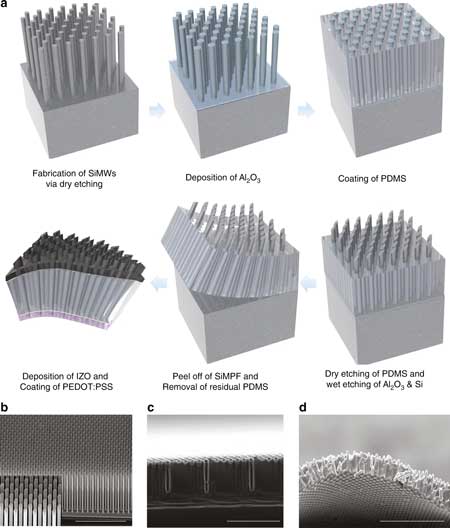| Dec 13, 2019 | |
Freestanding microwire-array enables flexible solar window(Nanowerk News) Transparent solar cells (TSC) are emerging devices that combine the advantages of visible transparency and light-to-electricity conversion. One of the valuable prospective applications of such devices is their integration into buildings, vehicles, or portable electronics. Therefore, colour-perception and flexibility are important as well as the efficiency. |
|
| Currently, existing transparent solar cells are based predominantly on organics, dyes, perovskites and amorphous Si; however, the colour-tinted transparent nature or rigidity of those devices strongly limits the utility of the resulting TSCs for real-world applications. | |
| In a paper published in Light Science & Application ("Stretchable and colorless freestanding microwire arrays for transparent solar cells with flexibility"), scientists from Department of Materials Science and Engineering, Ulsan National Institute of Science and Technology, Republic of Korea and co-workers developed flexible and efficient transparent solar cells which have colour-neutrality. | |
 |
|
| a Schematic of fabrication process. SEM images of b Si microwire arrays in a bird’s-eye view (scale bar: 50 µm), c Si microwire array filled with PDMS after surface treatment (scale bar: 50 µm), and d freestanding SiMPF after peeling off from the Si parent (scale bar: 100 µm). (© NPG) (click on image to enlarge) | |
| Based on the silicon microwires embedded in the transparent polymer matrix, they demonstrated transparent, flexible and even stretchable solar cells. This freestanding film was successfully utilized for building block of transparent solar cells. | |
| A heterojunction between n-type Si and p-type polymeric semiconductor is formed at the top portion and a transparent conductive film at the bottom of the device. The transparency of the devices can be tuned from ~ 10% to 55% by adjusting the spacing between the microwires. | |
| Moreover, after the cyclic bending test or under the bending state, the performance was maintained without a significant decrease. indicating that the transparent solar cells have excellent flexibility. | |
| This stretchable and transparent freestanding-form of microwire array / polymer composites film in this study is promising for future transparent solar cells. | |
| Transparent solar cells have an unavoidable trade-off between the energy generation and the light admission. Therefore, based on the criteria for transparent solar cells, there is an inevitable compromise of the efficiency to achieve transparency. This makes transparent solar cells difficult to get high performance. | |
| Overcoming this issue, these scientists suggest their strategy to obtain high performance transparent solar cells: "Basically, the solar cells can generate the electricity from the absorbed light. Therefore, attaining the high performance as maintaining the transparency is very challenging. We revealed absorption mechanism inside Si microwire-array and developed the new morphology of microwire which can manipulate the path of light. As a result, we successfully enhanced light absorption which can contribute to the light-generated-current in the transparent solar cells maintaining the transparency." | |
| "The transparent solar cell based on the freestanding film with advanced light-absorption technique shows the power conversion efficiency over 8 % at 10 % of visible transparency, which are comparable to state-of-the-art neutral-colour transparent solar cells based on organics and perovskites," they added. | |
| "Moreover, the devices are based on the Si wafer already verified and widely used in the Si solar cell market. Therefore, this robust, ultra-light and flexible platform is feasible and promising as a commercialized transparent solar cell for practical application in the future" the scientists forecast. |
| Source: Changchun Institute of Optics, Fine Mechanics and Physics | |
|
Subscribe to a free copy of one of our daily Nanowerk Newsletter Email Digests with a compilation of all of the day's news. |
